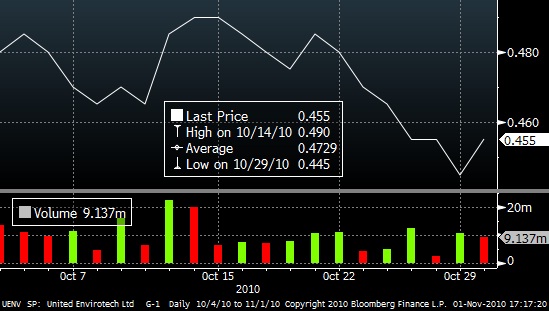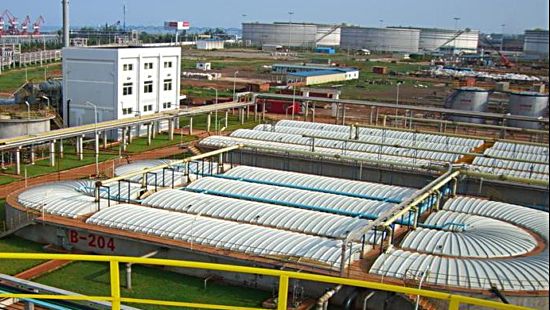
WATER TREATMENT stock United Envirotech (UEL) rebounded yesterday to close at 45.5 cts after it posted 1H2011 net profit growth of 144% to S$10.3 million this morning.
Group revenues for the first half of its financial year ending Mar 2011 were S$45.4 million, up 125.3% on higher engineering income, thanks to its completion in Sep of Asia’s largest underground membrane bioreactor (MBR) wastewater treatment plant.
The plant, completed in Sep, was worth contract value of a whopping Rmb 264 million and is able to treat 100,000 cubic meters of water per day for the Jingxi vicinity in Guangzhou.
Net margins improved to 22.7%, up 1.8 of a percentage point.
In Sep, UEL also completed and commenced operations for Phase I of the Hegang wastewater treatment cum recycling plant in Heilongjiang Province.
|
|||||||||||||||
This is UEL’s first project with dual service components and revenue streams: it will receive revenue from the government for treating 50,000 cubic meters of wastewater daily and sell 30,000 cubic meters of recycled water to chemical plants in a nearby industrial park.
Cash reserves decreased 17.2% to $30.9 million, mainly due to cash outflow for its BOT projects in Hedong city, Heilongjiang province.
China’s increased water budget and demand for membrane technology
Being one of the world's leading providers of membrane-based water and wastewater treatment and recycling solutions, UEL will have an important role to play as China addresses its chronic under supply and contamination of water resources in its 12th five-year plan (2011-15).

China’s annual per capita water resources is only 2,201 cubic meters, less than a third of the world average of 7,044 cubic meters, according to a Daiwa report dated 29 Oct.
Distribution is also an issue, with resources concentrated in the southern and eastern portions of the country, making water relatively scarce in the north and the west.
The problem is a widespread one: In China's 660-odd cities, over 400 are now confronting water shortages, 110 of them severe.
This is made worse by China’s rapid urbanization and industrialization, which have caused wastewater volumes to increase from 43.3 billion metric tons in 2001 to 57.2 billion metric tons in 2008.
With the discharge of untreated wastewater into rivers and streams, the nation's scarce water resources became contaminated.
In particular, pollution levels of nearly half of the water from the drainage systems of the Seven Great Rivers — Changjiang (Yangtze), Huanghe (Yellow), Songhuajiang, Liaohe, Zhujiang (Pearl), Haihe, and Huaihe — have apparently rendered it undrinkable.
This is despite gradual headway made in water quality through increased numbers of wastewater treatment facilities. In short, poor water quality is aggravating the chronic water shortages.

Government reform over 2001-2008 has already spurred water sector investments to swell 5 times to Rmb 104.5 billion.
When compared to industrialized nations, however, China's wastewater treatment coverage is still low at 70% in major urban areas and 30% in small cities by end 2010, according to its 11th 5-year plan (2006-2010).
Industry watchers believe that the push to upgrade its water infrastructure should continue until it reaches average wastewater treatment coverage comparable to major urban areas of advanced nations, i.e. around 80% to 90%.
Chinese media is reporting forecasts that its water budget in its 12th 5-year plan (2011-2015) will increase to as much as 1 trillion yuan, three times what was allocated for 2006-2010.
And Daiwa expects the market for water in China to quadruple from US$31 billion in 2009 to US$124 billion in 2025, making it the world’s largest.
Industry insiders quoted in the Daiwa report believe there will be higher water supply standards in 2012. What this means is greater demand for membrane technologies such as that provided by UEL.
And we are talking about huge demand: the market share for application of membrane technology in water treatment has been estimated by China's Ministry of Environment Protection to grow to as much as 27% by 2015, up from 5% in 2009.
Related story: CHINA ENVIRONMENT, UNITED ENVIROTECH: What Analysts Say







